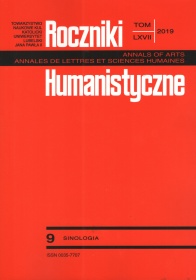How to Create a Language for the Whole People? On the Codification of Putonghua Pronunciation
Abstrakt
Jak stworzyć język dla wszystkich ludzi? O kodyfikacji wymowy Putonghua
Proces tworzenia nowoczesnego języka narodowego dla całych Chin był długi. Zaczął się na początku XX wieku, kiedy stało się jasne, że potrzebny jest wspólny język, by zjednoczyć Chińczyków. W ten sposób powstała koncepcja Guóyǔ — „języka narodowego”.
Po założeniu Chińskiej Republiki Ludowej prace zostały wznowione, standard został przemianowany na Pǔtōnghuà — „wspólną mowę”. Jego wymowa opiera się na dialekcie Pekinu, dialekty mandaryńskie były źródłem leksyki, a gramatykę oparto na „modelowych pracach w báihuà”.
Jak jednak dokładnie wyglądały prace nad stworzeniem nowego standardu? Ten artykuł ma na celu pokazanie procesu kodyfikacji wymowy tego, co obecnie znamy jako Pǔtōnghuà. Dlaczego postanowiono wybrać mowę Pekinu jako punkt wyjścia, jak przebiegały prace, a także jak zmieniał się sam standard?
Bibliografia
Chen, Ping. 2004. Modern Chinese: History and Sociolinguistics. Cambridge: Cambridge University Press.
Chen, Ping. 2015. “Language Reform in Modern China.” In William S.-Y. Wang and Chaofen Sun (eds.). The Oxford Handbook of Chinese Linguistics, 531–40. Oxford: Oxford University Press.
Dong, Hongyuan. 2014. A History of the Chinese Language. London and New York: Routledge.
Duanmu, San. 2002. The Phonology of Standard Chinese. Oxford: Oxford University Press.
DeFrancis, John. 1967. “Language and Script Reform”. In Thomas A. Sebeok (ed.). Current Trends in Linguistics. Vol. 2: Linguistics in East Asia and South East Asia, 130–50. The Hague, Paris: Mouton.
DeFrancis, John. 1984. The Chinese Language. Fact and Fantasy. Honolulu: University of Hawaii Press.
Lin Yen-Hwei. 2007. The Sounds of Chinese. Cambridge: Cambridge University Press.
Lü Jiping 吕冀平 (ed.). 2002. Dāngqián Wǒguó Yǔyán Wénzì de Guīfànhuà Wèntí 当前我国语言文字的规范化问题 [The problems of the standardization of modern Chinese language and writing]. Shanghai: Shanghai Jiaoyu Chubanshe.
Norman, Jerry. 1988. Chinese. Cambridge: Cambridge University Press.
Quanguo Renda Jiao Ke Wen Wei Weiyuanhui Jiaoyushi Jiaoyubu Yuyanwenzi Yingyong Guanlisi 全国人大教科文卫委员会教育室教育部语言文字应用管理司 [National People’s Congress’ Education, Science, Culture and Public Health Committee’s Education Office and Ministry’s of Education Administrative Department of Language Application]. 2001. Zhōnghuá Rénmín Gònghéguó Guójiā Tōngyòng Yǔyán Wénzì Fǎ Xuéxí Dúběn 中华人民共和国国家通用语言文字法学习读本 [A handbook of the People’s Republic of China law of the country’s common language and writing]. Beijing: Yuwen Chubanshe.
Saillard, Claire. 2004. “On the Promotion of Putonghua in China: How a Standard Language Becomes a Vernacular.” In Minglang Zhou (ed.). Language Policy in the People’s Republic of China: Theory and Practice Since 1949, 163–76. Kluwer Academic Publishers.
Shi Dingxu. 2016. “Standard Chinese.” In Chan Sin-Wai (ed.). The Routledge Encyclopedia of the Chinese Language, 723–35. London, New York: Routledge.
State Bureaus administered by Ministries or Commissions. 2014. China.org.cn. Accessed 24 March 2018. http://www.china.org.cn/china/leadership/2013-03/11/content_28206251.htm.
Tan Dazheng 谈大正 (ed.). 2000. Hànyǔ de wénhuà tèzhēng yǔ guójiā tōngyòng yǔyán wénzì 汉语的文化特征与国家通用语言文字 [Cultural characteristics of the Chinese language and the common language and script of China]. Beijing: Zhongguo Fazhi Chubanshe.
Wang, Feng, and Yaching Tsai. 2015. “Chinese writing and literacy.” In William S.-Y. Wang and Chaofen Sun (eds.). The Oxford Handbook of Chinese Linguistics, 554–64. Oxford: Oxford University Press.
Wang Xiaodong 汪晓东 et al. 2016. “Luán píng: Pǔtōnghuà zuì biāozhǔn dì dìfāng 滦平:普通话最标准的地方” [Luanping: the most standard place of Putonghua]. Xiao Kang 小康. Insight China: 90–1.
Yuan Jiahua 袁家骅. 2003. Hànyǔ fāngyán gàiyào (Dì’èr bǎn) 汉语方言概要(第二版) [An outline of Chinese dialects (second edition)]. Beijing: Yuwen Chubanshe.
Zhang Jianqiang 张建强. 2008. “Pùmén dìfāng pǔtōnghuà yǔyán tèzhēng fēnxī 铺门地方普通话语言特征分析” [Analysis of the characteristics of Pumen local Putonghua]. Journal of Hezhou University 贺州学院学报 2008年02期: 74–6.
Zhongguo Shehui Kexueyuan Yuyan Yanjiusuo Cidian Bianjishi 中国社会科学院语言研究所词典编辑室 [The Dictionary Department of the Institute of Linguistics of the Chinese Academy of Social Sciences]. 2002. Xiàndài Hànyǔ Cídiǎn (Hàn Yīng Shuāngyǔ) 现代汉语词典(汉英双语)[The Contemporary Chinese Dictionary (Chinese-English Edition)]. Beijing: Waiyu Jiaoxue yu Yanjiu Chubanshe.
Zhongguo Shehui Kexueyuan Yuyan Yanjiusuo Cidian Bianjishi 中国社会科学院语言研究所词典编辑室 [The Dictionary Department of the Institute of Linguistics of the Chinese Academy of Social Sciences]. 2016. Xiàndài Hànyǔ Cídiǎn. Dì 7 bǎn 现代汉语词典. 第7版 [The Contemporary Chinese Dictionary. Seventh Edition]. Beijing: Shangwu Yinshuguan.
Zhou Enlai 周恩来. 1956. “Guówùyuàn guānyú tuīguǎng Pǔtōnghuà de zhǐshì 国务院关于推广普通话的指示” [State Council Instructions concerning the Spreading of Putonghua]. The Central People’s Government of the People’s Republic of China. Accessed 12 September 2018. http://www.gov.cn/test/2005-08/02/content_19132.htm.
Copyright (c) 2019 Roczniki Humanistyczne

Utwór dostępny jest na licencji Creative Commons Uznanie autorstwa – Użycie niekomercyjne – Bez utworów zależnych 4.0 Międzynarodowe.





